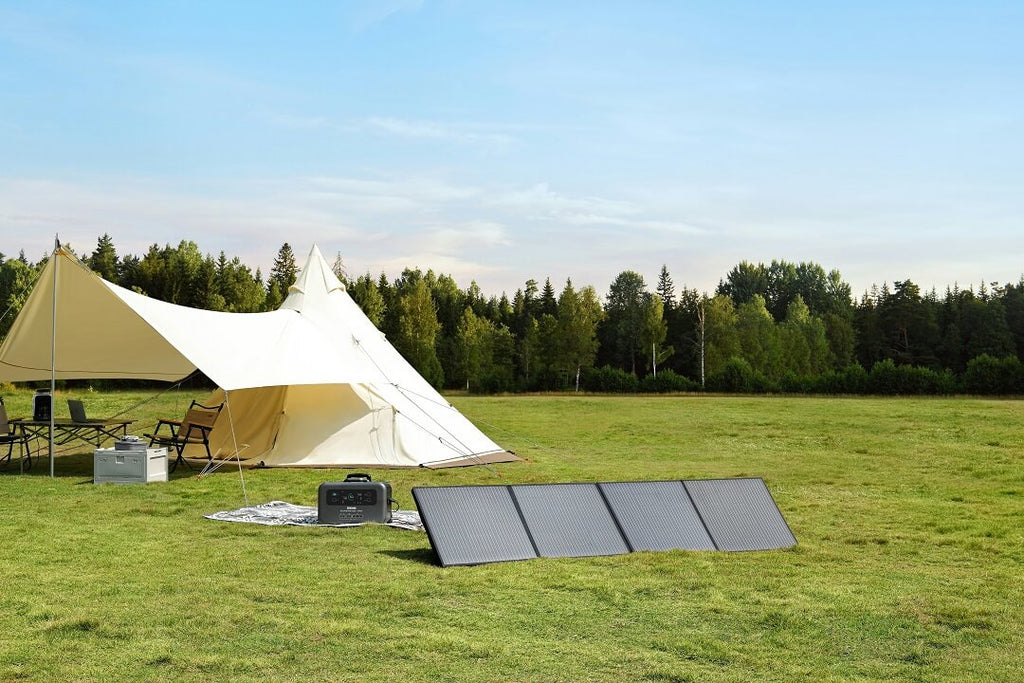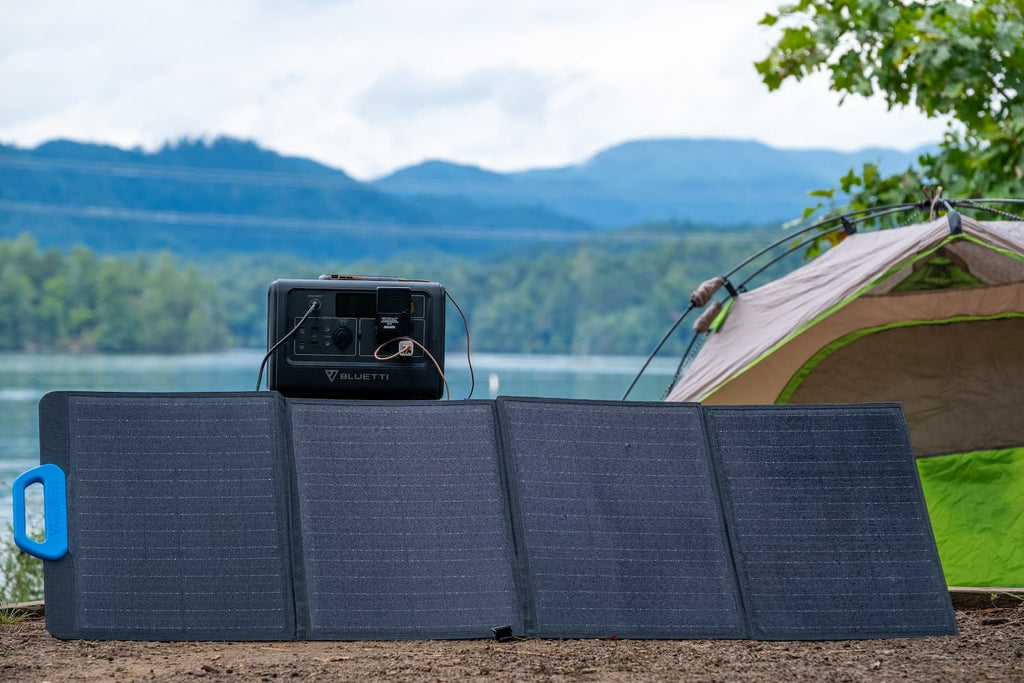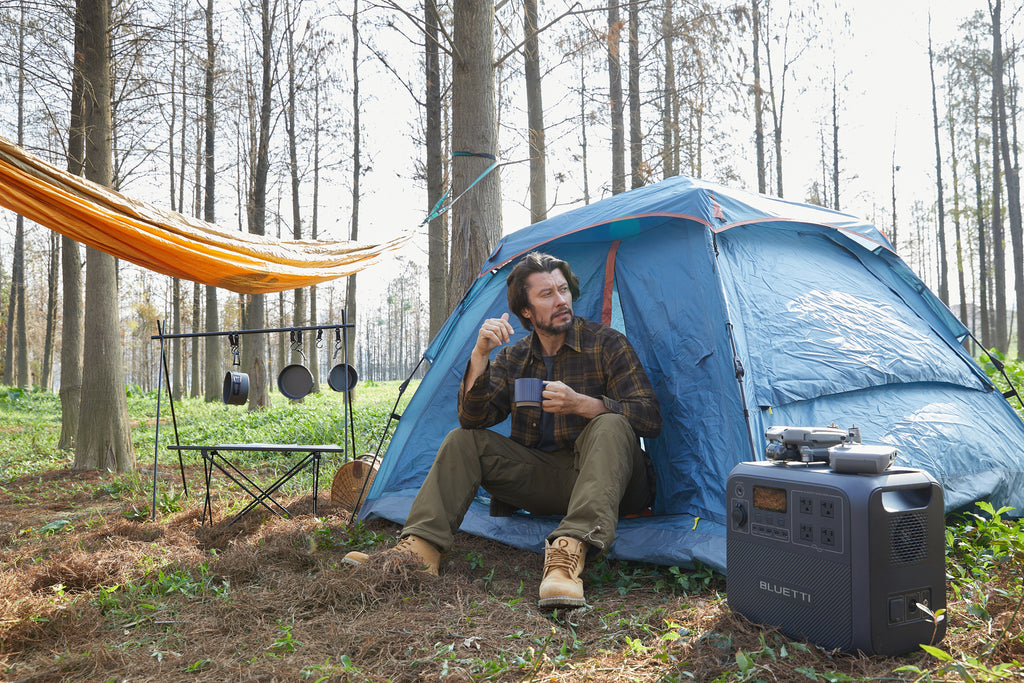Up for an adventure in the wilderness, are you? But wait! Before you begin your camping trip, you need to buy camping solar panels to ensure a smooth and relaxing journey for yourself.
Read on to learn all about the types of camping solar panels there are and which would be best for you. You will also get to know the best solar panels in the market, along with the battery to buy with them.
Read till the end!
What You Can Power With Camping Solar Panels?
Suppose you are out in the wild. You have various electrical appliances with you, such as smartphones, tablets, cameras, portable lights, portable speakers, etc. Of course, you have all these appliances to enhance your camping experience.
So, what happens if you can’t use them due to a lack of electrical power? Your fun will be ruined, won’t it? However, worry not. Camping solar panels are here for your rescue. They can power all these small electrical appliances with ease.
Furthermore, suppose you have somewhat bigger electrical appliances like a mini refrigerator, coffee maker, or water cooler. In that case, you can power them as well if you have a bigger camping solar panel system.

What Type of Solar Panel Is Best for Camping?
There are three different camping solar panels available in the market. That said, which one you opt for depends ultimately on your power requirements, available space during camping, and budget.
- Monocrystalline Solar Panels
- Cost: Monocrystalline solar panels have the highest price among camping solar panels. The reason lies in their complex manufacturing process, which involves cutting cells from a single silicon crystal.
- Appearance: They are black in color - which is a result of the interaction of light with the pure silicon crystal. Their back sheets and frames are available in many colors, although black is the most common. After all, when they are black, they blend most easily with your rooftop.
- Efficiency: Offering the highest efficiency, monocrystalline solar panels exceed the efficiency rate of 22%. They also offer power capacities often above 300W, with some reaching over 400W as well.

In addition, they perform better in warm temperatures due to their lower temperature coefficients.
- Material: Monocrystalline solar panels are made from a single crystal of silicon. While it is true that their production process ends up wasting silicon, it is no cause for worry. This is because this excess material is utilized for polycrystalline cells.
- Note: If you have high power needs and less space during camping, select monocrystalline ones as your camping solar panels. While the upfront price is high, you will benefit greatly due to their higher efficiency and power capacity.
- Polycrystalline Solar Panels
- Cost: Polycrystalline solar panels are generally lower in price than monocrystalline solar panels. This is because their manufacturing process is simpler - it involves melting fragments of silicon together.
- Appearance: They are bluish in color - resulting from the reflection of light off the silicon fragments. Their frames are usually available in silver, with the back sheets in white or silver.
- Efficiency: Polycrystalline solar panels have lower efficiency and power capacity than monocrystalline solar panels. The efficiency rate rarely exceeds 17%. Their physical size is similar to monocrystalline panels, commonly available in 60, 72, and 96 cell configurations.
- Material: These camping solar panels are manufactured by melting multiple silicon fragments together.
- Note: If you have relatively lesser power needs and larger available space, you can opt for polycrystalline ones as your camping solar panels.
- Thin Film Solar Panels
- Cost: Thin film solar panels are made from various materials, such as CdTe, CIGS, or a-Si. Among them, the CdTe panels are the cheapest, while CIGS panels are more expensive.
However, besides their material, thin film solar panels generally have the lowest price among camping solar panels.
- Appearance: You can buy thin film solar panels in either black or blue color. They are thinner and slimmer compared to the crystalline solar panels.
- Efficiency: Thin film solar panels have the lowest efficiency - generally around 11%. Their power capacity per square foot is also typically lower than crystalline solar panels.
- Material: They are made from various materials, including cadmium telluride (CdTe), amorphous silicon (a-Si), or copper indium gallium selenide (CIGS). They are characterized by their layer of photovoltaic material placed on a solid substrate like glass, plastic, or metal.
- Note: If you are tight on budget and do not have that many power requirements, you can opt for thin film ones as your camping solar panels.
|
Cost |
Appearance |
Efficiency |
Material |
|
|
Monocrystalline Solar Panels |
High |
Black |
High |
Made from a single crystal of silicon |
|
Polycrystalline Solar Panels |
Lower than monocrystalline solar panels |
Blue |
Lower than monocrystalline solar panels but higher than thin film ones |
Made by melting multiple silicon fragments together |
|
Thin Film Solar Panels |
Lower than both crystalline solar panels |
Black or blue |
Lower than both crystalline solar panels |
Made from CdTe, CIGS, or a-Si |
How Much Solar Power Do I Need for Camping?
If you are going camping, which vehicle will you use? Is it a camper van or a recreational vehicle (RV)? Further, are you going alone or with some companions such as friends or family? How long do you intend to stay there?
Secondly, as a person out camping, you would generally have small appliances like a smartphone, a tablet, a camera, lights, and a water cooler.
There can be some bigger appliances, like a mini refrigerator, coffee maker, air conditioner, etc, in the RV or camper van. Which of these appliances will you have, and for how long will you be using them?
Depending on your answers to these questions, the solar power you require will vary. If you are out camping alone, no matter which vehicle you have, your power requirements will be relatively less than if you have companions with you.
Now, the ultimate question is, how much solar power do you need for camping? Generally, 50W to 100W of solar power is sufficient to run all the small appliances. You might need solar power of 200W or greater if you have many bigger appliances to charge.
At the same time, also ensure that you add a buffer - some additional solar power to the one you calculated. This is important because oftentimes, the power used from camping solar panels ends up exceeding the power calculated.
Is 200W Solar Enough for Camping?
A 200W solar panel provides sufficient power to run several of your electrical appliances. Examples include a laptop, LED lights, an energy-efficient mini refrigerator (typical of an RV), and a coffee maker, among other appliances, provided they are not running all the time.
So, if you are considering buying a 200W solar panel for camping, go for it! When considering where to purchase one, consider opting for the BLUETTI PV200 solar panel.
BLUETTI PV200 Solar Panel

The BLUETTI PV200 Solar Panel is a robust solar panel offering you 200W of power, capable of running your typical camping vehicle appliances.
Key Features:
Monocrystalline Solar Cells: Boasting highly efficient monocrystalline solar cells with up to 23.4% efficiency, the PV200 camping solar panels will provide you with all the power required to run all your electrical appliances.
ETFE Coating: It has an ETFE (Ethylene Tetrafluoroethylene) coating, providing you with highly durable camping solar panels.
Foldable and Portable: It is foldable and portable, allowing you to carry it around easily when going camping.
Compatibility: It works harmoniously with most solar generators with MC4 connectors. Therefore, you can connect it with any existing solar generators you have with MC4 connectors.
Check out more of BLUETTI’s solar panels.
Don't Forget You May Also Need a Battery
Now, while camping solar panels provide you with efficient and clean solar power, they, unfortunately, don’t store power. Storing power can be a great backup source for when there is no sunlight or cloudy weather.
Therefore, while you are out buying camping solar panels, it is a wise move to purchase a solar battery with it as well. This is especially so if you will be out camping for a long time or you are going to an area susceptible to cloudy weather.
When choosing a solar battery, the BLUETTI AC180 solar portable power station is an amazing battery to opt for.
BLUETTI AC180 Solar Portable Power Station

The BLUETTI AC180 Solar Portable Power Station is an impressive solar battery you will not regret buying alongside your camping solar panels when going camping.
Key Features:
Power Output: It has a 1,800W AC output, extendable up to 2,700W in powerlifting mode. With this, you can run all your electrical appliances while camping with ease.
Capacity: It boasts a capacity of 1,152Wh (with the AC180P variant offering 1,440Wh), thus providing you with a substantial amount of stored power when the Sun is not available.
11 Multiple Ports: It has 11 output ports, allowing you to charge various devices simultaneously without any issues.
4 Recharging Ways: You can recharge the AC180 in four ways: AC, solar, car, and generator, allowing you to charge it no matter where you are during your camping adventure. Convenient, isn’t it?
Is a Camping Solar Panel Worth It?
If you are a camping enthusiast, then yes, buying camping solar panels will definitely be worth it. Whether you are in an RV or a camper van, you will have electrical appliances with you, both for your sustenance and needs.
Therefore, having camping solar panels is essential for you to run all these appliances and enjoy your camping experience to its full extent. In addition, camping solar panels are an eco-friendly option, so you are protecting the environment at the same time.
Find the Best Camping Solar Panel
Overall, in order to find the best camping solar panels, you need to consider the duration of your camping trip, the space to be given to solar panels on your camping vehicle, and your budget.
Monocrystalline solar panels are a great option to consider if you have higher power needs for your electrical appliances in your camping vehicle. You can opt for polycrystalline ones if you have relatively lesser power needs.
Thin film solar panels have even lesser efficiency, so choose them if you have very few power requirements and if you are going camping for a short time.
To buy the best campaign solar panel, go for the BLUETTI PV200 and buy the BLUETTI AC180 with it as a battery.

